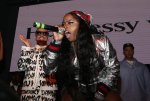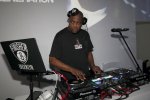“We were beginner’s in the hood as Five Percenters / But something must’ve got in us, ‘cause all of us turned to sinners…” -AZ on Nas’ “Life’s a Bi#ch”
Hip-Hop has lost its way… or shall we say balance. While flaunting money and drug game exploits run abundant, the lessons in the music have been submerged since capitalism took over and the jewels have been buried.
Hip-Hop Wired takes a look at what happened and the importance of the Five Percenter messages which were brought to the game.
Revisiting some classics and talking with some of the pioneers, it’s time for: “Each one to teach one.”
Speaking with Raekwon, Immortal Technique, Fab 5 Freddy, Poor Righteous Teachers’ Wise Intelligent and insight from Russell Simmons, get knowledge of self after the jump!!! [More]
“Rock from party to party, backyard to yard / I tear it up ya’ll and bless the mic for the Gods…” –Rakim “My Melody”
On February 5th of 2010, as blizzards swept across the northeastern part of the United States, hundreds of people braved the snowstorm and converged upon Trenton, New Jersey for a concert called “The Legends of Hip-Hop: Return of the God MC’s.” The show was headlined by Rakim and featured Brand Nubian, Cappadonna and Masta Killa of the Wu-Tang Clan, and hometown hero Wise Intelligent of Poor Righteous Teachers (PRT).
As the artists took to the stage and displayed the wizardry of their wordplay, the festivities transcended the run-of-the mill rap show. Reaching across the ages, grasping at the original purposes of such events throughout time, as the show progressed, it took on the spiritual dimensions of indigenous gatherings where traditions and beliefs were celebrated and reaffirmed; where commune with nature and the universe were reinforced.
Poor Righteous Teachers – “Holy Intellect”
This was more than just music, more than just message. It was a manifestation of a way of life that is at the core of what we now know as Hip-Hop culture.
Pulsating with Five Percenter vibrations, these lyrical alchemists metamorphosed the base elements of the teachings of the Nation of Gods and Earths into the golden wisdom of their songwriting. Indeed, some of the best to have ever touched the microphone have been students of, influenced by, or have utilized elements of the teachings of Nation of Gods and Earths, commonly known as Five Percenters.
This includes Jay-Z, Nas, Rakim, Busta Rhymes, Wu-Tang Clan, Brand Nubian, Poor Righteous Teachers, Gangstarr, Big Daddy Kane, LL Cool J, Big Pun; even Erykah Badu and the Digable Planets whose Grammy-Award winning ‘Rebirth of Slick (Cool Like Dat)” contains a line alluding to the Five Percent.
“The God, send you back to the earth from which you came.”-Jay-Z “Jigga My N***a”
The Nation of Gods and Earths was founded as the Five Percenters by Allah the Father (also referred to as Clarence 13X Smith), in 1964 after leaving the Nation of Islam’s mosque # 7, then under the leadership of Malcolm X. Using the foundational elements of his “Supreme Mathematics” and “Supreme Alphabets,” along with a core of the Nation of Islam’s “Supreme Wisdom” which he slightly modified to form the “120 Lessons,” he brought his own unique understanding of Islam as a way of life to the streets of New York.
From the streets of New York, his teachings spread across the United States and around the world. Rap music has had a part in the dissemination of these teachings. But then again, the teachings themselves are the roots of rap music and Hip-Hop culture on a whole.
In his autobiography, Life and Def: Sex, Drugs, Money, and God, Russell Simmons, a founding father of the rap music industry, labels the Nation of Gods and Earths as an “important influence” in the history of Hip-Hop that has been overlooked.
In her study, Five Percenter Rap: God Hop’s Music, Message and Black Muslim Message, documenting that Kool Herc reported a heavy Five Percenter presence at his parties, Professor Felicia M. Miyakawa observed:
“Even in the earliest days of Hip-Hop, the Five Percenters were regarded as an integral part of the Hip Hop scene.” The fact that an entire book has been published on the topic of Five Percenter influence on rap is a testimony to the strength of the impact.
It has also been reported that two of Hip Hop’s founders Kool Herc and Afrika Bambaataa personally studied Five Percent teachings as well. The foundational lessons of the Zulu Nation, the spiritual core of early Hip-Hop, were directly derived from the Supreme Mathematics and Alphabets. The Gods and Earths being a factor in the switch from street wars to street jams gels with what Russell Simmons further records in his autobiography.
“During the period when the gangs I hung with in the 70’s gave way to 80’s Hip Hop culture,” writes Simmons. “It was the street language, style and consciousness of the Five Percent Nation that served as a bridge.”
“Radios on card tables, Benetton, The Gods buildin’/Ask for today’s Mathematics, we Allah’s children / And this was going on in every New York ghetto / Kids listen, Five Percenters said it’s pork in Jell-O” – Nas “No Idea’s Original”
During the initial years of Hip-Hop’s formulation in various neighborhoods throughout New York City, the Nation of Gods and Earths was a formidable force in those same communities. This led to an inevitable cross-pollination whereby elements of Five Percenter culture were incorporated into the emerging world of Hip-Hop culture. The way that the Gods taught, for example, their “self-styled wisdom” way of speaking made them ideal for modeling rapping forms.
“Listen to rappers from Brooklyn or the Queensbridge projects, like Nas, and you hear Five Percent-speak all in their rhymes,” writes Simmons in Life and Def… “Rakim’s poetry is immersed in it. A lot of the poetic images in Hip-Hop are informed by them.”
Hip-Hop pioneer and host of the original Yo! MTV Raps, Fab Five Freddy expressed similar sentiments.
“The Five Percenter theology, thought process and of course, most importantly, the unique use of language had an indelible impact on Hip-Hop music.”
The Five Percent popularized use of the expressions “peace,” “word is bond” and even “keep it real.” Amongst the Gods and Earths, using the term “sun,” to describe your “mans and them” wasn’t because you felt they were like your kids, it was because Black Men were symbolic of the that great star at the center of our solar system, which symbolized the Black Family. Simmons presented a simplified explanation in his Life and Def:
“A Five Percenter will say some fly Shyte like, ‘I’ve got seven moons, three suns and two earths.’ It sounds mystical, but he’s really talking about all his women, with his two earths being his closest girls,” wrote Simmons. All of these things were incorporated into the Hip-Hop lexicon.
“I call my brother, Sun because he shine like one…” Method Man “Wu-Gambinos”
Other prime examples of foundational incorporations include “the cipher” and the “B-Boy stance.” Whereas in the Hip-Hop, the cipher is known as a circle of MCs spitting their lyrics, or the space wherein B-Boys boogied, it was adopted from “building in the cipher,” the practice of Gods and Earths forming a circle around a speaker “dropping science,” (another term adopted by Hip Hop) elaborating on the teachings of Supreme Mathematics and the 120 Lessons. In addition, sacred circles are long-standing traditions within indigenous cultures throughout the planet.
The B-Boy stance also is derived from Five Percenter posturing. “The B-Boy stance is originated as a Five Percenter thing,” says Fab Five Freddy. “I can remember the way the Gods would stand. The Gods would stand and have one foot there and you’d fold your arms and it was like… Whoa!” Historical images of the Gods “squared up” or “standing on the square” as it is called can be found throughout the photographic work of Jamel Shabazz.
As rap music infiltrated the music industry, the Nation of Gods and Earths were amongst the vanguard artists. The World Famous Supreme Team, See Divine “The Mastermind” & Just Allah “The Superstar,” were not only pioneering Hip-Hop radio personalities with the show they started in 1979 on Newark’s 105.9 WHBI-FM, they also created several early Hip-Hop hits in collaboration with British music maven, Malcolm McLaren.
These hits included international sensations such as 1983’s “Buffalo Gals” and 1984’s “Hey DJ.” McLaren’s 1983 album, Duck Rock, which is credited with Hip-Hop’s explosion in the United Kingdom, contained clips of the World Famous Supreme Team’s radio show. The late-great Mr. Magic, who went on to host the first rap show on a major radio station, worked on the show before moving to WBLS and “The Rap Attack.”
“With knowledge of self, there’s nothing I can’t solve, at 360 degrees I revolve…”–Rakim “Move the Crowd”
Eric B. & Rakim – “Follow The Leader”
In 1986, rap experienced a paradigm shift with the introduction of a Five Percenter named Rakim Allah to the music industrial scene. The relentless lyrical assault of “Eric B. is President” was biting us, fighting us and inviting us to the rhyme, while the smoothed out serenade of the B-Side “My Melody” seduced us into its lyrical lacework only to trample us under thunderous drum beats. And with that, Rakim revolutionized the way rappers rapped in much the same way T La Rock’s “It’s Yours” changed lyrical structure in 1984 and Grandmaster Flash and the Furious Five’s impacted subject matter with 1982’s “The Message.”
But Rakim wasn’t the only one. Just-Ice had made his Back to the old School debut with Mantronix. The following year, while Just-Ice teamed up with KRS-ONE, Brooklyn’s own King Asiatic made his debut as Big Daddy Kane as other groups, such as Divine Force, continued to bless the mic for the Gods.
With legendary and influential Five Percenter rappers such as Rakim and Big Daddy Kane impacting lyricism in rap music on a whole, it would stand to follow that Five Percenters have had a significant impact on the art of emceeing. Wu-Tang’s Raekwon the Chef expands on the topic.
“I think that when you look at brothers like Rakim that got knowledge of self that was coming with so many different words and making sense,” says Raekwon. “It made us more lyrical and more intelligent and I think it helped everybody’s rap sword in general.”
Big Daddy Kane – “Young, Gifted & Black”
“Let the Lessons be taught…” Poor Righteous Teachers “Time to Say Peace”
While Five Percent philosophy informed and peppered the works of artists such as Rakim and Big Daddy Kane, two groups formed in 1989, New Rochelle New York’s Brand Nubian, and Trenton, New Jersey’s Poor Righteous Teachers (PRT) brought the wisdom of the Nation and Gods and Earths front and center in their songs. PRT’s Holy Intellect and Brand Nubian’s One For All delved into Supreme Mathematics, Alphabets and 120 Lessons in depth.
The albums not only alluded to the teachings, they explored and contextualed120 Lessons within the daily life of the inner-cities. Lord Jamar’s verse on “All For One” even manifests the Supreme Mathematics in its entirety, as does the Grand Puba’s bridge on “Wake Up.”
Following a precedent set by the clip for Rakim’s “Move the Crowd,” videos for songs such as PRT’s “Rock Dis Funky Joint,” and especially their “Holy Intellect,” introduced us to Five Percenter imagery. Brand Nubian’s “Wake-Up” not only captured the nation’s headquarters at Harlem’s Allah School in Mecca on film, its dramatizations of some of the teachings were met with criticism and controversy. “I had been a Five Percenter myself as a youth,” says director Fab Five Freddy. “So I completely understood it… and tried to illustrate certain things.”
Brand Nubian – “Wake Up”
Another video for “Lost Tribe of Shabazz” by Lakim Shabazz, a Five Percenter and original member of New Jersey’s famed Flavor Unit (Queen Latifah, Naughty By Nature), is reportedly the first rap music video filmed in Egypt. Even the Hip-House video for King Sun’s “On the Club Tip” featured Five Percent iconography.
Nas feat. AZ – “Life A Bi%ch”
We were beginner’s in the hood as Five Percenters / But something must’ve got in us, ‘cause all of us turned to sinners… -AZ on Nas’ “Life’s a Bi#ch”
Along with artists such as Public Enemy and KRS-ONE, Five Percent rappers, were at the pinnacle of consciousness that defined rap’s “golden-era.” But as time went something changed within the music. The consciousness of the late 80’s and early 90’s was eclipsed by an emphasis on the glamorizing the grimier aspects ghetto life and so-called “gangsta rap.”
“1992, after the riots behind Rodney King, that’s when I started to see the change,” says PRT’s Wise Intelligent. “We had just finished our second recording, it was called Pure Poverty. We were explaining poverty and what it could do to a youth. So 1992 is when the paradigm shifts, because after the Rodney King riots, the youth were motivated to attack the cause of their problems…
The Youth were listening to “Fight the Power,” Public Enemy, KRS-ONE… They were politically oriented in the right direction. So they said ‘how can we stop this?’ We shift the paradigm! We turn them into ‘Niggas With Attitudes.’”
Public Enemy – “Fight The Power”
The demise of the positive element of Hip-Hop was not just part of the normal course of artistic cycles. “Being that I’m from Harlem, and that’s where the Five Percenters were founded in the 60’s, I think it was something that impacted me personally,” says Immortal Technique.
As for the teachings being shifted from the spotlight, Immortal sees it as profit driven.
“[Corporate America] said, you know what “I’m not here for your revolution, I’m not here for this Black medallion Shyte and it became almost cool to be ignorant. When this became strictly a part of Americanized corporate structure, that’s when the corruption crept through.”
While rap music as a whole had changed, the mid-90’s also saw a return to prominence of Five Percent terminology and ideology primarily due to ascendance of the Wu-Tang Clan. They combined the factors of peppering their verses with Supreme Mathematics and Alphabets and explorations of the teachings into their creations. Skits on the debut album Enter the Wu-Tang (36 Chambers) and the early solo efforts were filled with use of the language and lines derived from Five Percent teachings.
“One thing we always knew about the Nation was that it’s a culture,” says Wu-Tang’s Raekwon the Chef who had song titles on his Only Built for Cuban Linx… debut such as “Knowledge God” that reflected Five Percent influence. “It’s a way of life, so we kind of brought that way of life into existence inside the Hip Hop and it kind of made us all become more sharper, more wiser, more intelligent, more witty and at the same time more great in the heart with this music that we making. I felt like it did for the world.”
When ODB said that he’d be sticking pins in your head like a f*c*ing nurse, he was referring to a degree in the lesson known as the 1-40. When Ghost refers to going to get his “Culture Cipher” on the intro skit to “Wu-Tang: 7th Chamber,” he is using Supreme Mathematics. When Ghost talks of “Cee Allah Rule” he is using Supreme Alphabets to describe a car.
“We was very much into it deeply and we incorporated it in our rhymes because that’s how we talked everyday. If we was going to the store to get a 40-Ounce, we’d be like: ‘Yo, going to get that Culture Cipher’ or whatever it may be. Or if you got a pair of Gucci’s on, we’d say for short ‘God, Gods’or whatever, that was just the Staten Island way of representing the Shyte we was saying out there.”
There were some who were critical of the use of Five Percent lingo in such a fashion, while others were intrigued by it and sought to learn more about its origins.
“At that time we weren’t worrying about what people thought, It was just a language that if you caught it, you caught it, if you didn’t, maybe one day you’ll catch it. One thing about us, we always really just tried to keep it so 100 with what we like to talk about and how we talk,” says Raekwon.
“When the people caught on we was like okay, cool, we know ya’ll identify with it. It ain’t really hard to tell. It was just a universal language for the people who really knew what we was talking about at that time.”
In recent years, Five Percenter based depictions have also made their way onto the silver screen and television in films such as 1998’s Belly and Lord Jamar’s portrayal of “Supreme Allah” on season four of HBO’s Oz series. These depictions often focus on the negative elements associated with individuals who may have studied Five Percent teachings but still adhere to a criminal way of life.
These characterizations, such as LL Cool J’s “God” character in 1999’s In Too Deep, have helped to skew the perception of the Nation of Gods and Earths in mainstream pop culture. Brief, yet righteous representations can be found in RZA’s cameo in 1999’s Ghost Dog and in Eminem’s 8 Mile of 2002, where, in the free-style cipher sequence, female Five Percent rapper Njeri Earth has a brief opportunity to reflect her way of life.
But the Five Percent remain at the root of Hip-Hop, and as a part of its ongoing legacy.
“The Nation put a lot of things in perspective for Hip Hoppas,” says Raekwon.
“For kids just growing up in general because what I learned from the Nation is it brings forth a lot of knowledge, a lot of wisdom and a lot of understanding and I think that when you’re coming up and you don’t really have that side of it together when you’re coming up because you usually get into a lot of bullShyte, it kind of like grounds you and it matures you at the same time.”
Lord Jamar – “The Streets, The Corner”
A definitive example of God and Earth teachings presented in musical form can be found on Lord Jamar’s The 5% Album, released in 2006. Popa Wu, an elder and mentor to Wu-Tang Clan who has featured on several Wu-Tang projects, appears on the The 5% Album and has made recent appearances “building” on Raekwon’s Only Built for Cuban Linx… Pt. II and on Kay Slay’s More Than Just a DJ.
Artists who adhere to the teachings continue to release material in Hip-Hop’s thriving underground and those influenced by them such as Immortal Technique continue the duty of bringing civilization to the savage amongst us through their art. Jay Electronica, one of the most talked about rising talents in today’s rap music industry is also among the many continuing the God’s righteous legacy.
Regardless of whom or what, the builders will always continue to build.
For more insight, peep Hip-Hop Wired’s previous feature as we looked at the origin of The Gods & Earths!!!
Happy Physical Day To Allah: The Father: Founder Of The 5%ers”
Poor Righteous Teachers – “Shakiyla”















